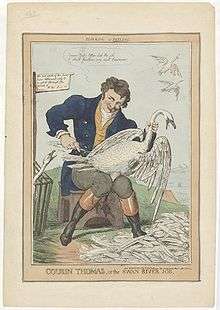Thomas Peel
Thomas Peel (1793 – 22 December 1865)[1] was one of the very early settlers of Western Australia. He was a second cousin of Sir Robert Peel. He was part of the military force behind the Pinjarra massacre in 1834, which saw 15-80 of the indigenous Binjareb people killed.[2]
Thomas Peel | |
|---|---|
 No photograph or portrait of Thomas Peel is known to exist. This is a contemporary caricature. | |
| Born | 1793 Lancashire, England |
| Died | 22 December, 1865 Mandurah, Western Australia |
| Nationality | British Australian |
| Education | Harrow School |
| Occupation | Settler |
| Relatives | Sir Robert Peel (second cousin) |

Biography
Early life
Thomas Peel was born in Lancashire, England, the second son of Thomas Peel and his wife Dorothy, née Bolton.[1] He was educated at Harrow School and was employed by attorneys.
Adult life in Australia
In 1828, he went to London with plans to migrate to New South Wales. However, Peel and three others including an MP, Potter McQueen, formed a consortium to found a colony at the Swan River in Western Australia by sending settlers there with stock and necessary materials. The consortium requested a grant from the British Colonial Office in London of 4,000,000 acres (16,000 km²). The government declined this and offered a grant of 1,000,000 acres (4,000 km²) on certain conditions.
Early in 1829, all the members of the consortium withdrew except Peel. Fresh conditions were made, the final arrangement being that if Peel landed 400 settlers before 1 November 1829, he would receive 250,000 acres (1,000 km²). If the conditions were fulfilled, Peel would receive further grants. Solomon Levey was a silent partner.[1]
To deliver the 400 settlers Peel chartered three vessels, Gilmore, Hooghly, and Rockingham. Gilmore, the first to leave, sailed from St Katherine Docks in July 1829 with Thomas Peel and 182 settlers in all.
Gilmore arrived in the Swan River Colony (later expanded and renamed Western Australia) on 15 December, around six weeks later than the government had stipulated. As he had not fulfilled the conditions, the land grant was no longer reserved for him. The land eventually granted to him, 250,000 acres (1,000 km²) of land to the south, extended from Cockburn Sound to the Murray River. He named the settlement Clarence, after the Duke of Clarence.
Hooghly (173 passengers), arrived at Clarence on 13 February 1830. Rockingham (180 passengers), arrived in mid-May 1830. She was wrecked shortly after landing her passengers, but all survived.
The early settlement struggled due to lack of labour and limited good-quality farming land. This, together with Peel's poor organising skills, meant that he was soon in difficulties. Within less than two years, he had spent £50,000 and some of his settlers had deserted him. Stores and stock, which were to be sent from Sydney by Cooper & Levey did not arrive.[1] Eventually Peel discharged all but a few from their indentures. In September 1834, Peel was granted further land, but he had little success in developing it. Peel became a member of the Western Australian Legislative Council, but resigned fourteen months later.[1] Some other pioneers (like James Henty) moved to Tasmania and the Port Phillip district.
Peel died on 22 December 1865 at age 72. He was buried in the churchyard in Mandurah.
Pinjarra massacre
In October 1834, Peel was a part of the force, which also included James Stirling and John Septimus Roe, that were involved in the Pinjarra massacre that resulted in the deaths of an uncertain number of Binjareb people.[2] Peel's involvement in the massacre was so that he could attract settlers into his land at Mandurah and to take revenge for the killing of his servant Hugh Nesbitt. In later years, he at one point described the local Binjareb people as a "nest of hornets".
In 2017, a campaign was started to rename the Peel region because of its ties to Peel, in part as a means to come to terms with the past. The MLA for Murray-Wellington Robyn Clarke supported the project but Premier Mark McGowan dismissed the idea of a renaming.[3][4]
Legacy and cultural references
Karl Marx referred to Peel in his analysis of capitalism, in a passage where he criticised colonist Edward Gibbon Wakefield:[5]
Mr. Peel, he moans, took with him from England to Swan River, West Australia, means of subsistence and of production to the amount of £50,000. Mr. Peel had the foresight to bring with him, besides, 3000[sic] persons of the working-class, men, women, and children. Once arrived at his destination, "Mr. Peel was left without a servant to make his bed or fetch him water from the river." Unhappy Mr. Peel who provided for everything except the export of English modes of production to Swan River!
References
- Alexandra Hasluck, 'Peel, Thomas (1793 - 1865)', Australian Dictionary of Biography, Vol. 2, MUP, 1967, pp 320-322. retrieved 2009-11-04
- Bates, Daisy M. (5 August 1926). "Battle of Pinjarra: Causes and consequences". The Western Mail. p. 40. Retrieved 30 July 2012.
- "Traditional Owners campaign to rename Peel region". Green Left Weekly. 28 October 2017. Retrieved 27 June 2019.
- Hondros, Nathan (26 October 2017). "'I'm not into changing the names of regions': Premier rejects Peel name change". WAtoday. Retrieved 27 June 2019.
- Marx, Karl (1867). Engels, Frederick (ed.). Das Kapital: Kritik der politischen Ökonomie [Capital: A Critique of Political Economy] (in German). 1. Translated by Moore, Samuel; Bibbins Aveling, Edward; Untermann, Ernest (4th ed.). New York: The Modern Library. p. 840. OCLC 70747658.
Further reading
- Appleyard R T and Manford T The Beginning: European discovery and early settlement of Swan River, Western Australia (University of Western Australia Press, Nedlands 1979) ISBN 0-85564-146-0
- Hasluck, Alexandra: Thomas Peel of Swan River (Oxford University Press, Melbourne 1965)
- Serle, Percival (1949). "Peel, Thomas". Dictionary of Australian Biography. Sydney: Angus and Robertson.
- Peel Family (timeline) at Mandurah Community Museum